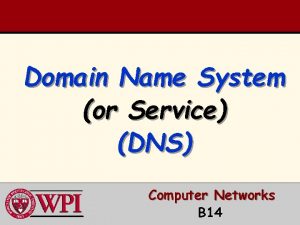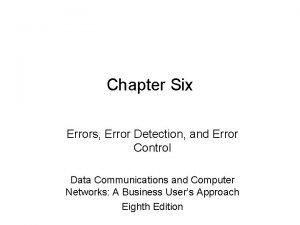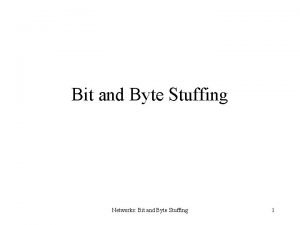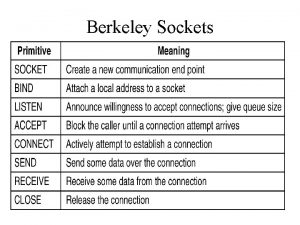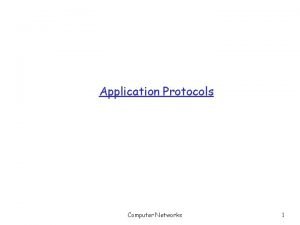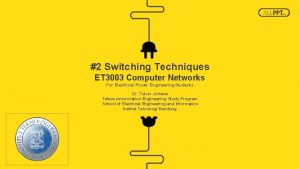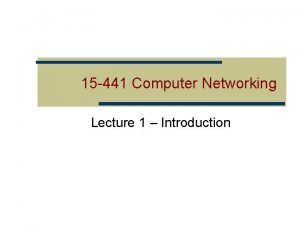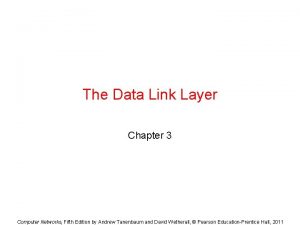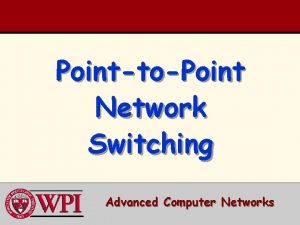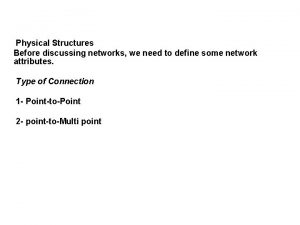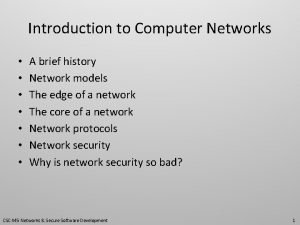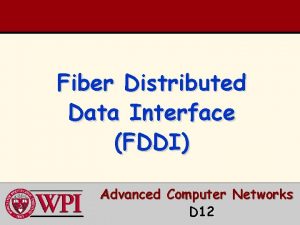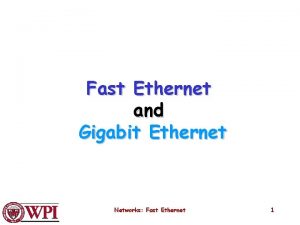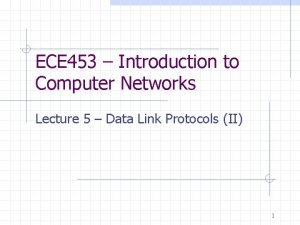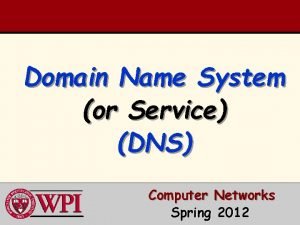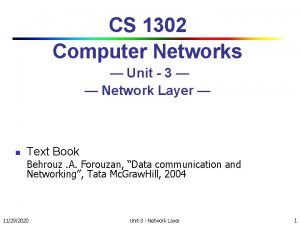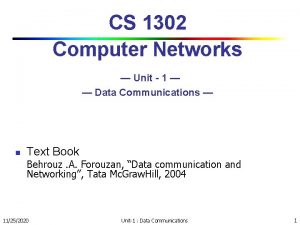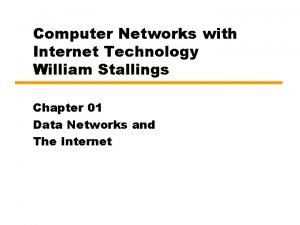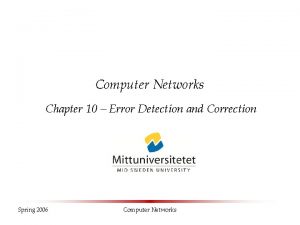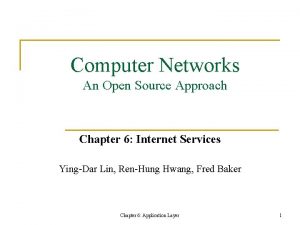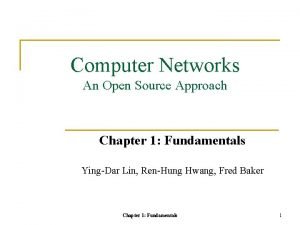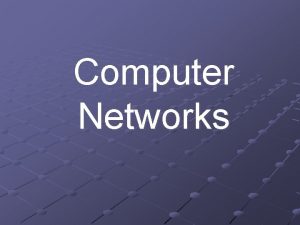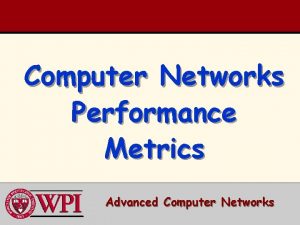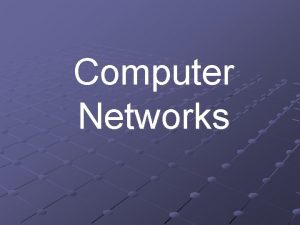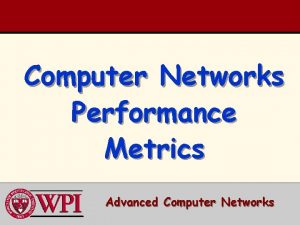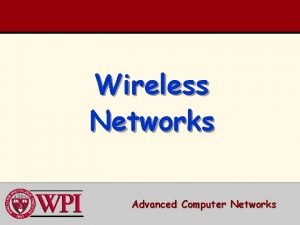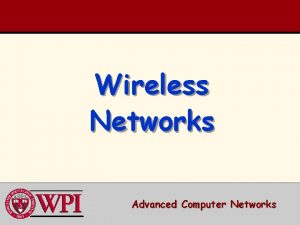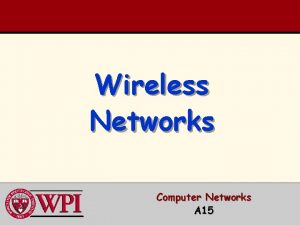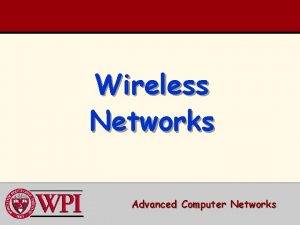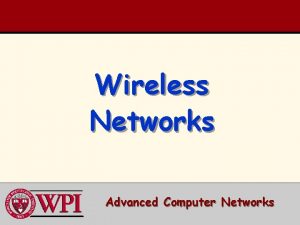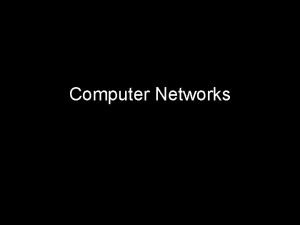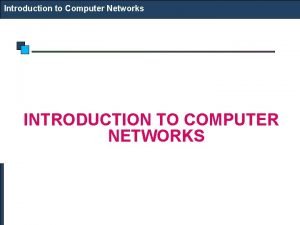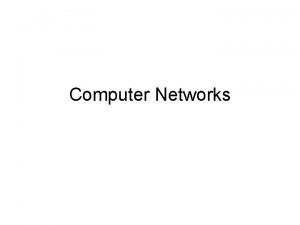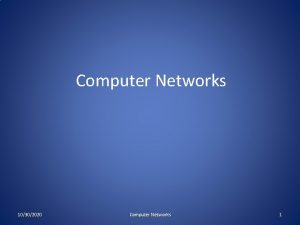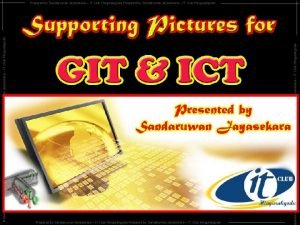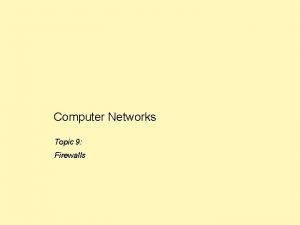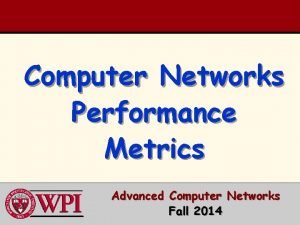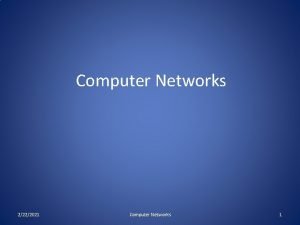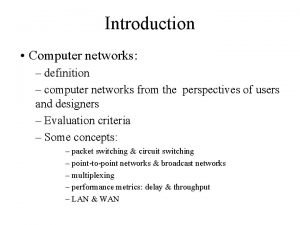Chapter 9 Computer Networks Chapter 9 Computer Networks























































- Slides: 55

Chapter 9 Computer Networks

Chapter 9 Computer Networks Chapter Outline Network Topology Addressing and Routing Media Access Control Network Hardware OSI Network Layers TCP/IP Focus – Voice over IP Network Standards Focus - Ethernet Focus - Upgrading Network Capacity (Part II)

Chapter Goals • Compare and contrast bus, ring, and star network topologies • Describe packet routing across local and wide area networks • Describe the CSMA/CD media access control protocol • Describe network hardware devices, including network interface units, routers, and switches • Describe the OSI network model, the TCP/IP protocol suite, and IEEE network standards

Chapter 9 Computer Networks

Network Topology • Spatial organization of network devices, physical routing of network cabling, and flow of messages from one network node to another • Can be physical or logical • Three types – star, bus, ring – differentiated by – Length and routing of network cable – Type of node connections – Data transfer performance – Susceptibility of network to failure

Point-to-Point Network Topology Impractical for all but very small networks

Point-to-Point Network Topology Impractical for all but very small networks

Point-to-Point Network Topology Impractical for all but very small networks

Advanced Network Topologies Improve practicality for most networks

Store and Forward System Centralizes the work of networking

Network Topologies • Uses a central node to which all end nodes Star are connected • Relatively simple wiring • Connects each end node to a common transmission line Bus • Relatively simple wiring • Low susceptibility to failure • Connects each end node to two other end nodes • Long maximum network length Ring • Low susceptibility to noise and distortion • Susceptible to failure and difficulty in adding, removing, or moving nodes

Star Topology Uses a central node to which all end nodes are connected Relatively simple wiring

Bus Topology Connects each end node to a common transmission line Low susceptibility to failure Relatively simple wiring

Ring Topology Connects each end node to two other end nodes Low susceptibility to noise and distortion Long maximum network length Susceptible to failure and difficulty in adding, removing, or moving nodes

Physical Star / Logical Bus Topology The strengths of two different topologies can be combined by using one topology for physical layout and another for message routing.

Addressing and Routing • How messages sent by end nodes find their way through transmission lines and central nodes to their ultimate destination • Local area networks (LANs) – Interconnected to form WANs • Wide area networks (WANs)

Local Area Network Routing • Each central node maintains and uses a routing table to make routing decisions • LAN hub or switch usually handles packet routing • Logical network topology determines exact procedure for routing a message between two end nodes in the same LAN

Example of a WAN Includes • end nodes • LANs • zone networks • backbone network • central nodes

LAN Central Node Routing Decisions

Wide Area Network Routing • Packet routing uses a store and forward approach • Forwarding stations can be implemented using – Bridges – Routers – Switches

Media Access Control • Uses a protocol that specifies rules for accessing a shared transmission medium – Carrier Sense Multiple Access/Collision Detection (CSMA/CD) • Commonly used in bus networks to detect and recover from collisions – Token passing MAC protocol • Used by ring network topologies

CSMA/CD Protocol • Process – Listen and wait for an idle state – Transmit a packet – Listen for a collision – If a collision is detected • First wait for a random period of time • Then retransmit the same packet • Primary Advantage – Simplicity • Primary Disadvantage – Potentially inefficient use of data transfer capacity

Token Passing MAC Protocol • Token passes from node to node – in a predetermined order • includes all nodes on network – in a specified time interval • Only the node that “possesses” the token is allowed to transmit messages – All others can only receive and repeat messages • No longer used in LANs; rarely in WANs

Effect of CSMA/CD Protocol on Network Throughput

Network Hardware Devices

Network Interface Units (NIUs) • Interface between network node and network transmission medium • Scan destination address of all packets – In bus network • ignores packets not addressed to it – In ring network • retransmits all packets not addressed to it • Implement media access control functions

Hubs • Connect nodes to form a LAN • Most are Ethernet devices • Combine separate point-to-point connections between nodes and the hub into a single shared transmission medium by repeating all incoming packets to every connection point • Low-cost alternative for home and small office networks

Bridges • Connect two networks or network segments and copy packets between them • Look at source addresses and update internal tables of node addresses on each network segment • Common uses – Construct a virtual LAN from two separate LANs – Divide a network into segments in order to minimize congestion

Routers • Intelligently route and forward packets among two or more networks • Forward packets based on information other than destination address • Build internal “map” of the network – constantly scan the netework to monitor traffic patterns and network node changes

Switches • High-speed devices that create virtual LANs on a per-packet basis • Each input connection is treated as a separate LAN • Dramatically increase network performance – Connection decisions made by hardware based only on destination address – Each virtual LAN has only one sending and one receiving node • eliminates congestion

OSI Network Layers Open System Interconnection (OSI) model • ISO conceptual model that divides network architecture into seven layers • Each layer uses services of layer below and is unaware of other layer’s implementations • Uses: – General model of networks – Framework for comparing networks – Architectural roadmap that enhances interoperability among network architectures and products

OSI Network Model

Application Layer • Network service request and response • Contains programs that make and respond to high-level requests for network services – End-user network utilities – Network services embedded in the OS – Network service providers

Presentation Layer • Converts and formats data • Ensures correct interpretation of transmitted data – Encryption and decryption – Compression and decompression – Converting data between EBCDIC and ASCII – Font substitution • Primarily used by applications that format data for user display

Session Layer • Negotiates and implements high-level protocol parameters – – timeout half or full duplex synchronization quality of service • Establishes and manages communication sessions • Monitors communication to detect and resolve problems that arise once protocol has been established

Transport Layer • Formats messages into packets suitable for transmission over the network • Places messages within a packet data area and adds header/trailer information (network addresses, error detection data, packet sequencing data) • Gives packets to network layer for delivery • Examines packets for errors; requests retransmission if necessary (when receiving packets)

Network Layer • Routes packets to their proper destination • Those within central node interact with one another to exchange routing information and update internal routing tables

Data Link Layer • Transmits packets and bits • Interface between network software and hardware

Physical Layer • Transmits bit streams • Where communication between devices actually takes place • Includes hardware devices that encode and decode bit streams and the transmission lines that transport them

OSI Network Model

TCP/IP • The core Internet protocol suite • Delivers most services associated with the Internet – – File transfer via FTP Remote login via Telnet protocol Electronic mail distribution via SMTP Access to Web pages via HTTP • Predates and corresponds poorly to OSI model

IP Internet Protocol • Provides connectionless packet transport across LANs and WANs • Translates datagrams into format suitable for transport by physical network • IP layer can divide datagram into smaller units and transmit them individually – Attaches header information to each unit, including its sequence in the datagram

IP Internet Protocol • Assumes datagram will traverse multiple networks via nodes called gateways • Determines transmission routes via related protocols (ICMP, RIP) • IP nodes – Identified by unique 32 -bit address (nnn. nnn) – Periodically exchange routing information to keep tables current

Only the IP layer is implemented within the gateways

TCP Transmission Control Protocol • Provides connection-oriented packet transport to higher-level Internet service protocols, including HTTP, FTP, and Telnet – Provides framework to check for lost messages; explicitly establishes connection with intended recipient before transmitting messages • Performs connection management functions (verifying receipt, verifying data integrity, controlling message flow, securing message content)

TCP Transmission Control Protocol • Sender and recipient TCP layers maintain information about one another (message routes, errors encountered, transmission delays, status of ongoing data transfers) • Uses positive acknowledgment protocol to ensure data delivery • Establishes connections through a port and an socket

Vo. IP Voice over IP • Technologies/standards that carry voice messages and data over single packetswitched network • Lower cost than traditional public switched telephone network (PSTN) • Complex and competing standards • Transmission quality problems – packet loss – latency – jitter

H. 323 is an umbrella for many component protocols

Network Standards • IEEE 802 standards – Describe network hardware, transmission media, transmission methods, and protocols – Help ensure compatibility among products from competing vendors – Developed by committees whose membership is drawn from industry, government, and academia • Ethernet standard (802. 3) - very successful

IEEE 802 Network Standards

Ethernet No provision for packet priorities or guarantees of quality of service

10 Gigabit Ethernet

Business Focus – Upgrading Network and Storage Capacity • • Bradley Advertising Agency The trade-off between short and long-range benefits of copper and fiber optic wiring Copper is installed in most buildings, works well for current needs, and can be upgraded – Current technology pushes copper to its maximum Fiber optic cable has far greater theoretical capacity than copper – Current optical products are expensive and not yet perfected Fiber optic cable is the future – But when is it cost effective for a particular organization or need?

Summary • Network topology • Addressing and routing • Media access control • Network hardware • OSI network layers • Network standards

Chapter Goals • Compare and contrast bus, ring, and star network topologies • Describe packet routing across local and wide area networks • Describe the CSMA/CD media access control protocol • Describe network hardware devices, including network interface units, routers, and switches • Describe the OSI network model, the TCP/IP protocol suite, and IEEE network standards
 Datagram approach and virtual circuit approach
Datagram approach and virtual circuit approach Backbone networks in computer networks
Backbone networks in computer networks Crc in computer networks
Crc in computer networks Crc in computer networks
Crc in computer networks Traffic management in computer networks
Traffic management in computer networks Speed of a computer
Speed of a computer What is optimality principle in computer networks
What is optimality principle in computer networks Snmp model in computer networks
Snmp model in computer networks What is optimality principle in computer networks
What is optimality principle in computer networks Applications of computer networks
Applications of computer networks Definition of computer
Definition of computer Dns in computer networks
Dns in computer networks Diffserv vs intserv
Diffserv vs intserv Icmp in computer networks
Icmp in computer networks Http computer networks
Http computer networks Framing in computer network
Framing in computer network Dns in computer networks
Dns in computer networks Data communication assignment
Data communication assignment Distributed system in computer network
Distributed system in computer network Badrinath
Badrinath Error correction in computer networks
Error correction in computer networks Error detection and correction in computer networks
Error detection and correction in computer networks Internet transport protocol in computer networks
Internet transport protocol in computer networks Error control in computer networks
Error control in computer networks Subnet
Subnet Data link layer switching in computer networks
Data link layer switching in computer networks Layer task
Layer task Byte stuffing in computer networks
Byte stuffing in computer networks Byte stuffing and bit stuffing
Byte stuffing and bit stuffing Bit and byte stuffing in computer networks
Bit and byte stuffing in computer networks Socket berkeley
Socket berkeley Arp vs rarp
Arp vs rarp Ftp protocol in computer networks
Ftp protocol in computer networks Principles of network applications
Principles of network applications Switching techniques in computer networks
Switching techniques in computer networks 15-441
15-441 A utopian simplex protocol
A utopian simplex protocol Sonet/sdh in computer network
Sonet/sdh in computer network Cell switching in computer networks
Cell switching in computer networks Physical structures in computer networks
Physical structures in computer networks Osi model in computer network
Osi model in computer network Network layer design issues in computer networks
Network layer design issues in computer networks Brief history of computer network
Brief history of computer network Fddi network topology
Fddi network topology Fast ethernet network
Fast ethernet network Exponential backoff ethernet
Exponential backoff ethernet Unrestricted simplex protocol
Unrestricted simplex protocol Dns in computer networks
Dns in computer networks Analog and digital signals in computer networking
Analog and digital signals in computer networking Cs 1302
Cs 1302 Cs1302 computer networks
Cs1302 computer networks Congestion control principles
Congestion control principles William stallings computer networks
William stallings computer networks Error detection methods
Error detection methods Computer networks an open source approach
Computer networks an open source approach Bda max40
Bda max40
















